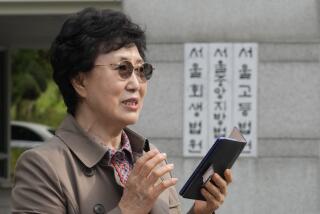Handing Over the Wanted Unwanted Child : AN OPEN ADOPTION <i> by Lincoln Caplan (Farrar, Straus & Giroux: $17.95; 137 pp.; 0-374-10558-8) </i>
When Peggy Bass, a 20-year-old college student, spotted an ad in her hometown paper from a couple seeking to adopt a baby, she was seven months pregnant. Lacking steady employment, her boyfriend Tom, a recent college graduate, was not yet ready for marriage.
Peggy called the number listed, which turned out to be a California agency specializing in arranging open adoptions. Over the phone, Peggy was read thumbnail sketches of three couples seeking to adopt. She selected one--an infertile Boston couple in their late 30s--who eventually would become her baby’s adoptive parents.
Author Lincoln Caplan, himself the adoptive father of a daughter, traces the saga of what is doubtless one of the most emotionally fraught of all human transactions: the transfer of a newborn from a woman whose life has no room for motherhood to a couple for whom a baby is a long-awaited miracle. Caplan uses the four-way story of Peggy, Tom and adoptive parents Dan Stone and Lee Duncan to elucidate the emerging trend toward open adoption, taking care to identify the many emotional pitfalls and legal hazards along the way.
Caplan, an attorney and author of “The Insanity Defense and the Trial of John W. Hinckley Jr.” and “The Tenth Justice: The Solicitor General and the Rule of Law,” defines an open adoption as “one in which the birth parents meet the adoptive parents, participate in the separation and placement process, relinquish all legal, moral and nurturing rights to the child, but retain the right to continuing contact and to knowledge of the child’s whereabouts and welfare.” For many birth parents, who find themselves increasingly in the driver’s seat vis-a-vis the placement of their progeny, open adoption offers an attractive alternative to the traditional, closed, confidential route (in which the birth mother surrenders her newborn to an agent or go-between, never to lay eyes on, or have any contact with, that child again).
A diminished pool of infants available for adoption in the United States--due in part to the prevalence of abortion and in part to the social acceptance of single parenting--and a markedly higher incidence of infertility among married couples have combined to make the search for the elusive infant a poignant, trying and common one. Indeed, for the last 15 years, just 50,000 babies annually have been put up for adoption, down from a peak of 89,200 in 1970, according to Caplan. “While the rate of out-of-wedlock birth doubled, the percentage of single mothers who gave up their babies dropped sharply,” he writes, noting that today 24 out of 25 unmarried new mothers choose to keep their unplanned babies.
Bass might have gone that route, too, were she not so headstrong about adoption and clever at concealing her condition from her parents. “She didn’t want to tell her family, with whom she lived . . . (as) she was sure they would insist on helping her keep the baby.”
After designating Dan and Lee as the adoptive parents for her child, Peggy moved to Boston so that they could offer support and be on hand for the birth of the baby she was already calling theirs. Aware of the delicacy of the situation, Dan and Lee honored Peggy’s wishes, housing her with friends and taking her out for dinner every week as if they were “dating” her. On the one hand, they wanted to do everything possible to ease her burden. On the other, they felt uneasy that Peggy’s and Tom’s parents had been kept in the dark about the pregnancy for fear that, upon discovery, they might contest the adoption. Further, Massachusetts law requires that the mother wait four days after giving birth before signing adoption papers--in order that she be able to change her mind. Braced for crushing disappointment (a non-factor in the case of closed adoption), they had to walk a highwire act around solidity while masking their vulnerability.
For her part, Peggy seemed never to doubt her decision and appeared to relish her role of birth mother, jokingly referring to herself as “the adoption fairy”; after childbirth, she attached to her daughter’s wrist the name Rebecca Duncan Stone. Ironically, despite Peggy’s magnanimity, it was she who eventually pulled away from the triangle. Returning home to Tom, she quickly got pregnant again, had an abortion, and before long the pair broke up. Through her mother, Peggy asked Dan and Lee to stop sending baby pictures; only then did they begin to fathom Peggy’s repressed anguish that summer.
Caplan does an able job of reporting the emotional currents swirling in this drama of maternity. However, much of the book fails to transcend a rough-draft feel, with its heavy use of blocks of transcript and the concomitant lack of authorial interpretive analysis. It is as if Caplan were trying to keep a distance from the material, holding his own emotions at bay in an attempt to maintain objectivity.
What’s more, he piles on unnecessary detail, such as what the couples ate for lunch the day they met, how they dressed, without demonstrating the emotional or character significance of these details. Given the slim, 137-page text, one cannot help but suspect Caplan of padding to stretch an article--much of which originally appeared in The New Yorker--into a box.
Still, for the reader unacquainted with the subject, “An Open Adoption” provides a useful introduction. Peggy’s story is interwoven with an overview of historical attitudes toward, and studies regarding, adoption, as well as the case for and against open adoption.
Perhaps the book’s most graphic image is of the rows of unwanted babies laid out in 1920s maternity wards; adoptive parents could stroll the aisles until one caught their fancy. In that era, unwed mothers were met with contempt. Today, unwed mothers willing to give up their infants for adoption have emerged as maternity princesses and are occasionally met at airports with limousines. This shift in the balance of power is no doubt disconcerting for would-be adoptive parents, most of whom are in a higher socio-economic class from the birth parents. Given this new landscape, however, despite their small troubles, Dan Stone and Lee Duncan appear to be a very lucky couple indeed.
More to Read
Sign up for Essential California
The most important California stories and recommendations in your inbox every morning.
You may occasionally receive promotional content from the Los Angeles Times.









